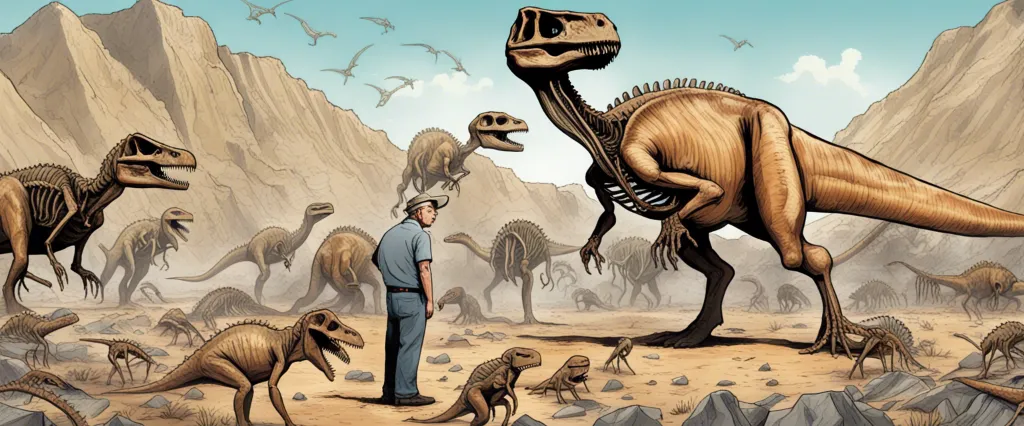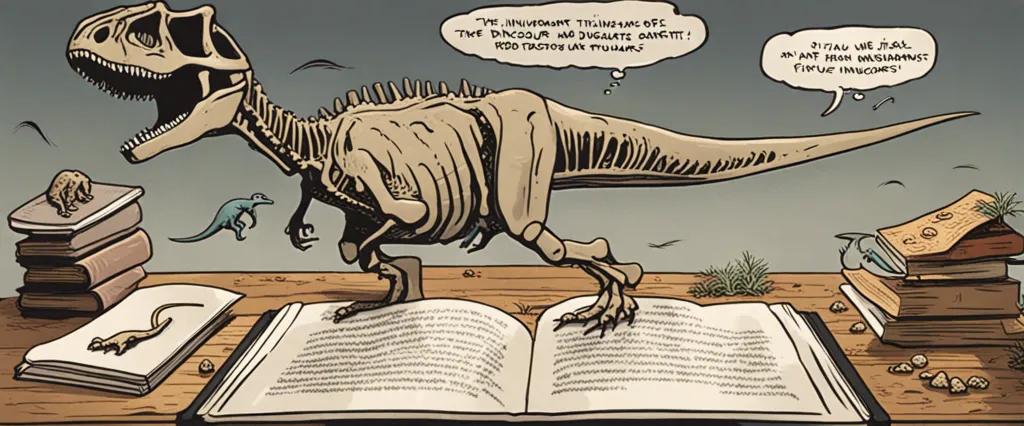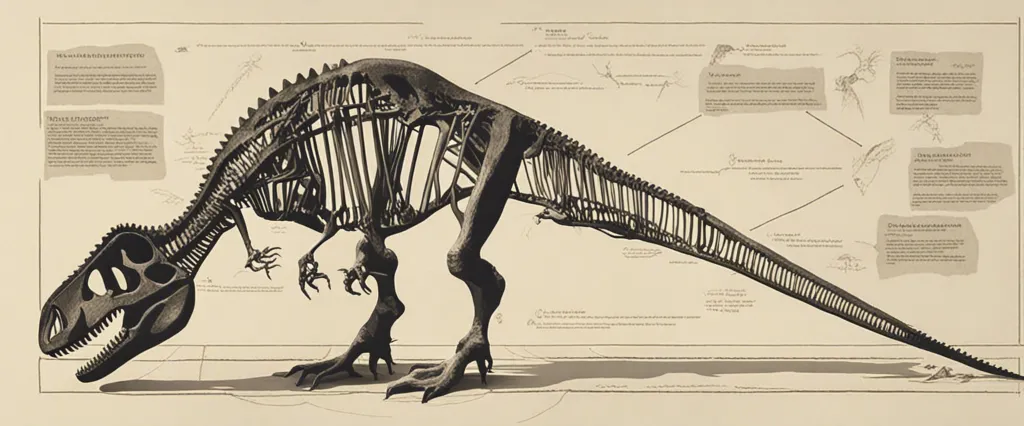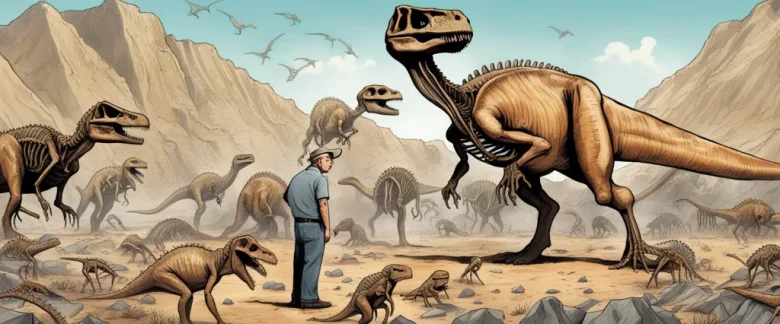
In “The Rise and Fall of the Dinosaurs,” renowned paleontologist Stephen Brusatte takes readers on an enthralling journey through millions of years, unraveling the incredible story of Earth’s most famous creatures. From their awe-inspiring origins to their dramatic demise, Brusatte systematically explores the science, history, and sheer fascination surrounding these colossal beings. A leading figure in modern paleontology, Stephen Brusatte is a professor of vertebrate paleontology at the University of Edinburgh. He has conducted groundbreaking research all over the globe, uncovering new dinosaur species and shedding light on the mysteries of their existence. Brusatte’s passion for dinosaurs is infectious, and his expertise makes him the perfect guide to navigate this captivating narrative.
Chapter 1: The Age of Dinosaurs
Chapter 1 of “The Rise and Fall of the Dinosaurs” by Stephen Brusatte, titled “The Age of Dinosaurs,” dives into the origins and evolution of these majestic creatures that once roamed the Earth. The chapter begins by setting the stage, explaining that dinosaurs originated over 230 million years ago in a world completely different from our own.
Brusatte takes readers back to the supercontinent Pangaea, explaining the harsh and volatile environment of the Triassic Period. At this time, dinosaurs coexisted with other reptiles, mammal ancestors, and even early forms of turtles and crocodiles. The author emphasizes the relatively humble beginnings of dinosaurs, as they were initially small and marginal creatures compared to the ruling reptiles of the Triassic.
The narrative then progresses to describe how a mass extinction event, caused by volcanic activity and climate change, paved the way for the dinosaurs to dominate during the Jurassic Period. This allowed them to diversify and evolve into a wide range of sizes, shapes, and ecological roles. Brusatte highlights the incredible adaptations that set dinosaurs apart, such as their ability to walk and run on two legs, their air-filled bones for better mobility, and their highly efficient respiratory systems.
Throughout the chapter, Brusatte introduces various important dinosaurs, such as Herrerasaurus, Coelophysis, and Plateosaurus, to exemplify the anatomical advancements and ecological niches occupied by these ancient creatures. By the end of the chapter, readers get a glimpse into the fascinating world of dinosaurs, setting the stage for the subsequent chapters that will explore their rise to dominance, their flourishing diversity, and their ultimate demise.
Chapter 2: The Rise of the Dinosaurs
Chapter 2: The Rise of the Dinosaurs from the book The Rise and Fall of the Dinosaurs by Stephen Brusatte explores the evolutionary journey and dominance of dinosaurs on Earth during the Late Triassic period, around 230 million years ago.
The chapter begins by setting the geological and environmental stage for the rise of the dinosaurs. Earth at this time was a world of shifting continents, active volcanoes, and alternating periods of intense heat and extreme cold. These dynamic conditions drove the evolution of new species, including dinosaurs, which gradually gained a foothold among the varied and densely populated reptile communities.
During the Late Triassic, dinosaurs faced fierce competition from other reptiles, particularly crocodile-like creatures called Phytosaurs and large amphibians known as Temnospondyls. However, dinosaurs began to thrive due to their unique adaptations, such as upright limbs and fast metabolisms, which allowed them to move faster and efficiently capture prey.
Brusatte introduces several new and important species that emerged during this time, including Eoraptor, a small and agile dinosaur considered one of the earliest known dinosaurs, and Herrerasaurus, a formidable predator. These discoveries shed light on the early evolutionary stages of dinosaurs and their remarkable ability to adapt and diversify.
Moreover, the chapter highlights crucial fossil findings in South America, such as those in Argentina, that provide valuable insights into the rise of dinosaurs. These South American fossils suggest that dinosaurs were already quite successful and diverse even before they spread to other continents.
In conclusion, Chapter 2 explores the emergence and success of dinosaurs during the Late Triassic period. It emphasizes the unique adaptations and evolutionary advantages that allowed dinosaurs to outcompete other reptiles and dominate the Earth, setting the stage for their eventual widespread proliferation and eventual fall.
Chapter 3: The Reign of the Dinosaurs
In Chapter 3: The Reign of the Dinosaurs of the book “The Rise and Fall of the Dinosaurs” by Stephen Brusatte, the author explores the extraordinary dominance of dinosaurs during the Mesozoic Era, also known as the Age of Dinosaurs. This chapter dives into the various aspects that contributed to their immense success over millions of years.
Brusatte sets the stage by describing the initial conditions of the early Triassic period, soon after the catastrophic mass extinction event that wiped out approximately 90% of all marine and terrestrial life. In this desolate world, dinosaurs emerged as one of several groups of reptiles trying to fill empty ecological niches. With an astonishing variety of shapes and sizes, ranging from small, bird-like creatures to colossal, long-necked giants, dinosaurs diversified and adapted to various environments. This diversification was facilitated by the evolution of features like sturdy legs, improved respiration systems, and lightweight air-filled bones, which helped them become agile and energetic creatures.
The chapter also considers the evolution of dinosaur ecosystems. Brusatte describes the changing landscape and emphasizes the significance of continental drift that created shifting continents and separated previously connected landmasses. This allowed for the formation of unique dinosaur faunas in different parts of the world, leading to varied ecosystems and unprecedented biodiversity.
Brusatte highlights specific dinosaurs that played crucial roles during this time, such as the apex predators like Allosaurus and Tyrannosaurus rex, as well as herbivores such as Triceratops and Stegosaurus. He also touches upon the concept of “tropical polar ecosystems,” highlighting the discovery of dinosaur fossils in polar regions, suggesting that even areas near the poles hosted a surprising abundance of life during the Age of Dinosaurs.
Overall, Chapter 3 delves into the exceptional success and expansion of dinosaurs across the globe, shedding light on their remarkable adaptability and their role in shaping the natural world during their reign.
Chapter 4: The Diversity of Dinosaurs

Chapter 4: The Diversity of Dinosaurs of the book The Rise and Fall of the Dinosaurs by Stephen Brusatte explores the incredible range of dinosaur species that existed during the Mesozoic Era. Brusatte begins by emphasizing that dinosaurs are not a homogenous group but rather a diverse array of animals that occupied different ecological niches.
He discusses the three main groups of dinosaurs: the ornithischians, the sauropodomorphs, and the theropods. The ornithischians were herbivores and included species such as Triceratops and Stegosaurus. The sauropodomorphs were large, long-necked herbivores like Brachiosaurus and Diplodocus. The theropods, on the other hand, were the carnivorous dinosaurs, which later evolved into birds. Famous theropods included the Tyrannosaurus rex and the Velociraptor.
The chapter also delves into the various subgroups within these three main groups, each with their own unique characteristics and adaptations. For instance, within the theropod group, there were the fierce and formidable carnivorous tyrannosaurs, the cunning and fleet-footed dromaeosaurs, and the bird-like troodontids.
Brusatte highlights several groundbreaking recent discoveries that have greatly expanded our understanding of dinosaur diversity. For example, the newly discovered feathered dinosaurs from China have provided crucial insights into the evolution of feathers and the complex relationship between dinosaurs and birds.
Additionally, the discovery of fossils in Antarctica has shed light on the presence of dinosaurs in extreme environments and their ability to adapt to different climates.
Overall, Chapter 4 illuminates the remarkable variety of dinosaurs that roamed the Earth millions of years ago, further dispelling the notion of dinosaurs as a single monolithic group. This chapter emphasizes the awe-inspiring and diverse nature of this long-extinct group of animals.
Chapter 5: The Extinction Event
Chapter 5 of “The Rise and Fall of the Dinosaurs” by Stephen Brusatte explores the catastrophic event known as the Cretaceous-Paleogene (K-Pg) extinction that wiped out the dinosaurs and many other species 66 million years ago. The chapter begins by contextualizing the flourishing world inhabited by dinosaurs during the Late Cretaceous period.
Brusatte explains that the K-Pg extinction was triggered by the impact of a massive asteroid, measuring around 10 kilometers in diameter, that crashed into present-day Mexico. The author describes the colossal devastation that ensued from this cataclysmic event, including ground-shaking earthquakes, colossal tsunamis, and heat surges. The sudden release of energy blasted out a gigantic hole and caused widespread fires, releasing toxic gases and dust particles into the atmosphere.
Brusatte delves into the aftermath of the impact. The skies were darkened by the thick layer of debris and soot blocking sunlight, leading to plummeting temperatures and disrupted food chains. The world was thrown into chaos, with enduring wildfires, acid rain, and widespread wildfires further exacerbating the global devastation. As a result, around three-quarters of all species, including non-avian dinosaurs, pterosaurs, marine reptiles, and many other organisms, became extinct.
Furthermore, Brusatte discusses the long-term consequences of the K-Pg extinction, highlighting how the event paved the way for the rise of other groups of animals, including mammals and birds. These survivors inherited the Earth and diversified immensely during the subsequent Paleogene period. Taking advantage of the ecological niches left vacant by the dinosaurs’ demise, mammals thrived and evolved into the diverse forms we see today.
In summary, Chapter 5 of “The Rise and Fall of the Dinosaurs” explores the catastrophic K-Pg extinction event and its consequences. It describes the impact of a monstrous asteroid, the immediate devastation it caused, and the long-lasting effects that shaped the world we currently inhabit.
Chapter 6: The Aftermath of Extinction
Chapter 6 of “The Rise and Fall of the Dinosaurs” by Stephen Brusatte, titled “The Aftermath of Extinction,” explores the period following the catastrophic event that wiped out the dinosaurs—the Cretaceous-Paleogene (K-Pg) mass extinction.
Brusatte begins by describing how the Earth recovered from the devastation caused by the meteor impact. The immediate aftermath saw massive wildfires, mega-tsunamis, and a “nuclear winter” effect due to the release of immense amounts of dust and aerosols into the atmosphere. Consequently, global temperatures dropped, sunlight was reduced, and plant life struggled to survive. Over the following decades, the climate gradually returned to normal, paving the way for a new era of life.
The chapter then delves into the evolution of mammals, who emerged as the dominant land dwellers in the wake of the extinction. Brusatte highlights how the few surviving mammal groups diversified rapidly, occupying ecological niches left vacant by the dinosaurs. He introduces readers to some of the unique mammalian groups that arose during this period, such as early primates and hoofed mammals, setting the stage for the eventual evolution of humans.
Moving beyond land, the chapter also explores the recovery of marine life. Brusatte discusses the rise of marine reptiles like mosasaurs, plesiosaurs, and sea turtles, as well as the remarkable success of sharks and ray-finned fish during the Mesozoic Era. However, it was the age of mammals that truly reshaped the oceans, with the emergence of iconic marine creatures like whales and dolphins evolving from earlier terrestrial ancestors.
Overall, Chapter 6 reveals the remarkable resilience and adaptability of life on Earth. In the wake of the K-Pg extinction, new ecosystems flourished, presenting a radically different world from the one dominated by dinosaurs.
Chapter 7: The Legacy of the Dinosaurs
Chapter 7 of “The Rise and Fall of the Dinosaurs” by Stephen Brusatte, titled “The Legacy of the Dinosaurs,” explores the aftermath of the extinction event that wiped out the non-avian dinosaurs 66 million years ago and the remarkable ways dinosaurs continue to influence the world today.
The chapter begins by emphasizing that birds are the living descendants of the dinosaur lineage. Brusatte details the evolutionary journey of birds, explaining how they diversified into various forms and adapted to different environments, leading to the over 10,000 bird species we have today. He highlights fascinating examples such as the ostrich, penguin, and hummingbird to demonstrate the diversity and impressive abilities of these modern-day dinosaurs.
Brusatte then dives into the impact of dinosaurs on humans. He discusses how dinosaur remains have captivated our imaginations, prompting scientific investigation and sparking popular culture fascination with these ancient creatures. The chapter also explores how dinosaur fossils have provided valuable insights into Earth’s history and the evolution of life. Brusatte shares tales of famous paleontologists who made groundbreaking discoveries, including Mary Anning, who uncovered several important Jurassic marine reptiles.
Furthermore, the chapter delves into the influence of dinosaurs on our understanding of biology and the process of extinction. Brusatte showcases how the study of dinosaur bones has led to discoveries about their physiology, growth patterns, and behavior, reshaping our vision of these ancient animals. By examining the extinction event that wiped out the dinosaurs, scientists have identified lessons that can inform our current conservation efforts and priorities in safeguarding Earth’s biodiversity.
In summary, Chapter 7 of “The Rise and Fall of the Dinosaurs” explores the ongoing legacy of these ancient creatures. It reveals how birds embody the living descendants of dinosaurs, showcases the impact of dinosaurs on human society and culture, and highlights the invaluable contributions dinosaurs have made to our understanding of Earth’s history and the natural world.

Chapter 8: Discoveries and Future Research
Chapter 8 of “The Rise and Fall of the Dinosaurs” by Stephen Brusatte explores the remarkable discoveries and future research that shape our understanding of these ancient creatures. Brusatte begins by discussing the paleontological expeditions that have uncovered new dinosaur fossil sites around the world. These expeditions have unearthed numerous dinosaur species, revealing their incredible diversity and shedding light on their evolutionary history.
One major discovery discussed in this chapter is the uncovering of early dinosaur fossils in the Southern Hemisphere, particularly in Brazil and Argentina. These findings challenge previous assumptions that dinosaurs originated in the Northern Hemisphere. Additionally, the discovery of dinosaur fossils in Antarctica provides valuable evidence of how they adapted to extreme cold environments.
Brusatte also delves into the innovative techniques and technologies that are revolutionizing the field of paleontology. These include advances in imaging techniques, such as CT scans and high-resolution X-rays, which allow scientists to study the internal structures of fossils without damaging them. Furthermore, he explores how ancient DNA analysis and isotope studies provide insights into dinosaur biology and behavior.
The chapter also touches on ongoing research projects and future endeavors that promise to expand our knowledge of dinosaurs. These include efforts to study dinosaur soft tissues and proteins, using cutting-edge methods to extract viable genetic material from fossils. Additionally, Brusatte discusses the potential for more discoveries in poorly explored regions like Africa and Asia, hinting at the possibility of uncovering even more dinosaur diversity.
Overall, Chapter 8 highlights the remarkable progress made in discovering and understanding dinosaurs, as well as the exciting avenues for future research that hold the promise of further expanding our knowledge of these fascinating creatures.
After Reading
In conclusion, Stephen Brusatte’s book “The Rise and Fall of the Dinosaurs” provides a fascinating account of the evolution and ultimate extinction of these ancient creatures. Through his meticulous research and engaging storytelling, Brusatte takes readers on a journey spanning millions of years and continents, highlighting the remarkable rise of dinosaurs as dominant creatures and their eventual downfall. Not only does he paint a vivid picture of their physical characteristics and behaviors, but he also delves into the evolving understanding of their biology and how they interacted with the changing environment. Ultimately, this book offers an enlightening and comprehensive overview of the dinosaurs’ extraordinary existence, leaving readers with a renewed appreciation for these enigmatic creatures that once reigned over our planet.
1. Educated” by Tara Westover
This memoir tells the inspiring story of Tara Westover, who grew up in rural Idaho in a strict household led by her survivalist parents. Despite facing numerous obstacles, including a lack of formal education, Westover managed to escape her oppressive upbringing and pursue an academic journey that led her to earn a PhD from Cambridge University. “Educated” is a beautifully written and thought-provoking exploration of the power of education and the pursuit of knowledge.
2. “The Tattooist of Auschwitz” by Heather Morris
Based on a true story, this historical fiction novel follows the life of Lale Sokolov, a Slovakian Jew who becomes the tattooist at Auschwitz concentration camp during World War II. Through Lale’s perspective, readers gain a unique insight into the atrocities of the Holocaust and witness the incredible resilience and love that can endure even in the darkest of times. “The Tattooist of Auschwitz” is a poignant and unforgettable tale of survival and redemption.
3. “Eleanor Oliphant Is Completely Fine” by Gail Honeyman
This debut novel introduces readers to Eleanor Oliphant, a socially awkward and eccentric woman living a solitary and predictable life. As the story unfolds, Eleanor’s life takes an unexpected turn when she meets Raymond, a kind-hearted IT guy from her office. Together, they embark on a journey of friendship and self-discovery that challenges Eleanor’s perceptions of herself and the world around her. “Eleanor Oliphant Is Completely Fine” is a touching and uplifting novel that explores themes of loneliness, mental health, and the power of human connection.
4. “The Nightingale” by Kristin Hannah
Set in France during World War II, “The Nightingale” tells the harrowing story of two sisters, Vianne and Isabelle, who are forced to navigate the complexities of war and make unimaginable sacrifices. As they each find their unique ways to resist the German occupation, their lives intertwine in unexpected ways, showcasing their unwavering strength, bravery, and resilience. This poignant and emotionally charged historical fiction novel reminds us of the untold stories of women during wartime and their incredible contributions to the fight for freedom.
5. The Alchemist” by Paulo Coelho
“The Alchemist” is a timeless and enchanting tale that follows the journey of a young shepherd named Santiago in search of his dream. Through encounters with a series of wise individuals, Santiago learns the importance of listening to one’s heart and following one’s destiny. This allegorical novel weaves together themes of self-discovery, faith, and the pursuit of one’s true purpose in life. The profound wisdom and lessons in “The Alchemist” make it a must-read for anyone seeking inspiration and personal growth.



